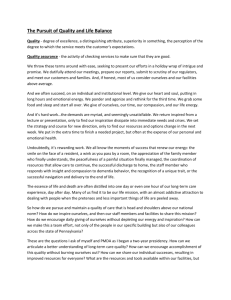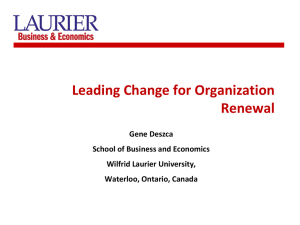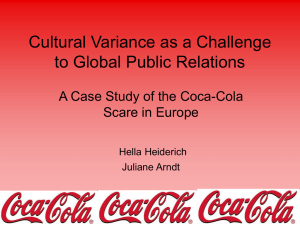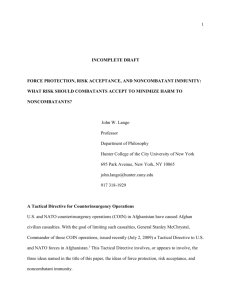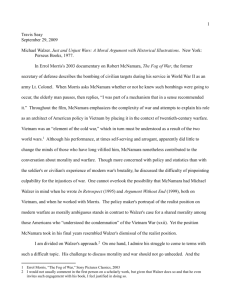Fuyuki KURASAWA Sociology @ York `4 “Cautionary Tales
advertisement
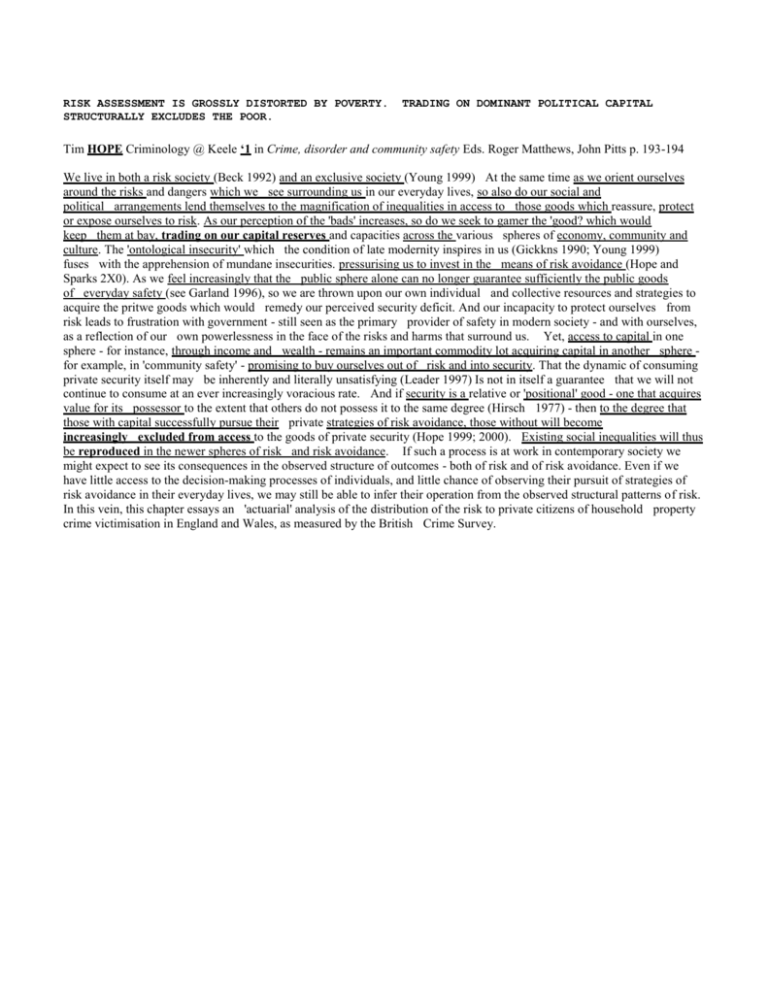
RISK ASSESSMENT IS GROSSLY DISTORTED BY POVERTY. STRUCTURALLY EXCLUDES THE POOR. TRADING ON DOMINANT POLITICAL CAPITAL Tim HOPE Criminology @ Keele ‘1 in Crime, disorder and community safety Eds. Roger Matthews, John Pitts p. 193-194 We live in both a risk society (Beck 1992) and an exclusive society (Young 1999) At the same time as we orient ourselves around the risks and dangers which we see surrounding us in our everyday lives, so also do our social and political arrangements lend themselves to the magnification of inequalities in access to those goods which reassure, protect or expose ourselves to risk. As our perception of the 'bads' increases, so do we seek to gamer the 'good? which would keep them at bay, trading on our capital reserves and capacities across the various spheres of economy, community and culture. The 'ontological insecurity' which the condition of late modernity inspires in us (Gickkns 1990; Young 1999) fuses with the apprehension of mundane insecurities. pressurising us to invest in the means of risk avoidance (Hope and Sparks 2X0). As we feel increasingly that the public sphere alone can no longer guarantee sufficiently the public goods of everyday safety (see Garland 1996), so we are thrown upon our own individual and collective resources and strategies to acquire the pritwe goods which would remedy our perceived security deficit. And our incapacity to protect ourselves from risk leads to frustration with government - still seen as the primary provider of safety in modern society - and with ourselves, as a reflection of our own powerlessness in the face of the risks and harms that surround us. Yet, access to capital in one sphere - for instance, through income and wealth - remains an important commodity lot acquiring capital in another sphere for example, in 'community safety' - promising to buy ourselves out of risk and into security. That the dynamic of consuming private security itself may be inherently and literally unsatisfying (Leader 1997) Is not in itself a guarantee that we will not continue to consume at an ever increasingly voracious rate. And if security is a relative or 'positional' good - one that acquires value for its possessor to the extent that others do not possess it to the same degree (Hirsch 1977) - then to the degree that those with capital successfully pursue their private strategies of risk avoidance, those without will become increasingly excluded from access to the goods of private security (Hope 1999; 2000). Existing social inequalities will thus be reproduced in the newer spheres of risk and risk avoidance. If such a process is at work in contemporary society we might expect to see its consequences in the observed structure of outcomes - both of risk and of risk avoidance. Even if we have little access to the decision-making processes of individuals, and little chance of observing their pursuit of strategies of risk avoidance in their everyday lives, we may still be able to infer their operation from the observed structural patterns of risk. In this vein, this chapter essays an 'actuarial' analysis of the distribution of the risk to private citizens of household property crime victimisation in England and Wales, as measured by the British Crime Survey. Fuyuki KURASAWA Sociology @ York ‘4 “Cautionary Tales: The Global Culture of Prevention and the Work of Foresight” Constellations 11 (4) p. 465-466 Up to this point, I have tried to demonstrate that transnational socio-political relations are nurturing a thriving culture and infrastructure of prevention from below, which challenges presumptions about the inscrutability of the future (II) and a stance of indifference toward it (III). Nonetheless, unless and until it is substantively ‘filled in,’ the argument is vulnerable to misappropriation since farsightedness does not in and of itself ensure emancipatory outcomes. Therefore, this section proposes to specify normative criteria and participatory procedures through which citizens can determine the ‘reasonableness,’ legitimacy, and effectiveness of competing dystopian visions in order to arrive at a socially self-instituting future. Foremost among the possible distortions of farsightedness is alarmism, the manufacturing of unwarranted and unfounded doomsday scenarios. State and market institutions may seek to produce a culture of fear by deliberately stretching interpretations of reality beyond the limits of the plausible so as to exaggerate the prospects of impending catastrophes, or yet again, by intentionally promoting certain prognoses over others for instrumental purposes. Accordingly, regressive dystopias can operate as Trojan horses advancing political agendas or commercial interests that would otherwise be susceptible to public scrutiny and opposition. Instances of this kind of manipulation of the dystopian imaginary are plentiful: the invasion of Iraq in the name of fighting terrorism and an imminent threat of use of ‘weapons of mass destruction’; the severe curtailing of American civil liberties amidst fears of a collapse of ‘homeland security’; the neoliberal dismantling of the welfare state as the only remedy for an ideologically constructed fiscal crisis; the conservative expansion of policing and incarceration due to supposedly spiraling crime waves; and so forth. Alarmism constructs and codes the future in particular ways, producing or reinforcing certain crisis narratives, belief structures, and rhetorical conventions. As much as alarmist ideas beget a culture of fear, the reverse is no less true. Fuyuki KURASAWA Sociology @ York ‘4 “Cautionary Tales: The Global Culture of Prevention and the Work of Foresight” Constellations 11 (4) p. 468 Last but not least, a just world order requires an attitude of stewardship of nature. By articulating the norms of precaution and global justice, we can formulate a more general evaluative template to guide public deliberation about different dystopian narratives. Three sets of considerations, each combining intentionalist and consequentialist elements, are particularly appropriate for this task: 1. Analytical: Is a particular scenario plausible according to credible knowledge of the past, the present, and the future? What evidence substantiates it? 2. Ethical: What values and principles underpin it? Does it strengthen or erode the work of preventive foresight, and specifically the principles of precaution and global justice? 3. Political: By whom is it adopted or rejected, in whose interests, and through what frameworks and institutions? What effects does this have, notably to what kind of future is it likely to contribute?41 Notwithstanding the overlap between these three dimensions in practice, it remains useful to distinguish between them for heuristic purposes. Applying them to the critique of misuses of farsightedness allows us to demonstrate that alarmism, for one, thrives by demagogically appealing to societal fears that can neither be substantiated nor correlated with plausible representations of reality. Further, fear-mongering aims to conserve questionable aspects of the status quo (say, regarding the weakness of environmental regulations) or to dangerously reshape domestic and global socio-political orders (in the case of belligerant unilateralism), in effect consolidating the positions of dominant groups and institutions. Alex BELLAMY Peace and Conflict Studies @ Queensland ‘4 “Supreme Emergencies and the Protection of Noncombatants in War” International Affairs 80 (5) p. 845-846 Given these four problems, the idea that it is legitimate to suspend the principle of non-combatant immunity in supreme emergencies is brought into serious question. First, although it can be defended against the charge of realism, it is a clearly utilitarian doctrine that contradicts Walzer’s rights-based approach to the ethics of war. There is a real danger that making what are otherwise considered to be fundamental rights conditional on criteria beyond the control of those in line to lose their immunity will have the effect of making rights secondary to utilitarian considerations. As in previous centuries, the right of non-combatant immunity would become instead a privilege bestowed by the opposing military on the condition that it did not contravene military necessity. Second, contemporary legal and moral thinking flatly rejects the direct targeting of noncombatants, in all circumstances. The idea that non-combatants may be intentionally targeted is simply not countenanced by contemporary international society.71 Third, Walzer’s thought experiment, which suggests that governments face ‘either–or’ choices in supreme emergencies, is a historical fallacy. There are always alternative courses of action, and where those alternatives have been foreclosed, it is usually because of the prior moral choices of the people or institutions involved. This is clearly demonstrated by the British decision to bomb German cities in 1940, which was not a decision ‘forced’ upon the RAF by necessity but a direct product of over two decades of strategizing. Finally, the idea that the direct killing of noncombatants can be essential to successful defence during a supreme emergency is strategically untenable. There is no evidence that the bombing of German cities staved off defeat or hastened victory. Indeed, it is difficult to recall a single case where killing noncombatants has won a war. In the 1990s, Bosnian Serbs and Rwandan Hutus both suffered military defeats in part because they directly attacked noncombatants. There is therefore good reason to reject Walzer’s supreme emergencies exception to non-combatant immunity.






